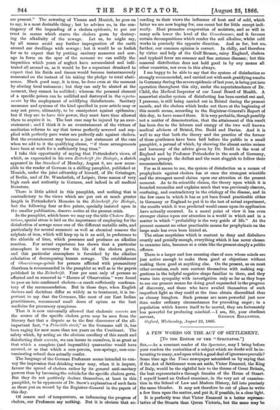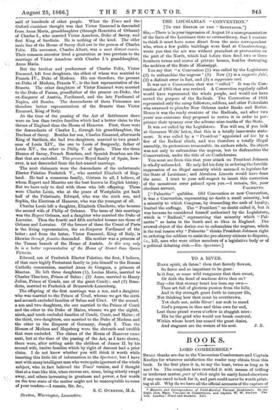A FEW WORDS ON THE ACT OF SETTLEMENT.
[TO THE EDITOR OF THE " SPECTATOR."]
SIE,—As a constant reader of the Spectator, may I bring before your readers the curiosities of a subject which no doubt will be in- teresting to many, and upon which a good deal of ignoranceprevails? Some time ago the Times newspaper astonished ua by saying that if the Act of Settlement were set aside, Victor Emanuel, the King of Italy, would be the rightful heir to the throne of Great Britain, the best representative through females of the House of Stuart. I myself heard an Oxford examiner, in the very act of examina- tion in the School of Law and Modern History, fall into precisely the same blunder. It may not therefore be out of place to write a few lines upon the matter, and put it, if possible, in a clear light.
It is perfectly true that Victor Emanuel is a better represen- tative of the Stuarts than Queen Victoria, but the same may be
said of hundreds of other people. What the Times and the Oxford examiner thought was that Victor Emanuel is descended from Anna Maria, granddaughter (through Henrietta of Orleans) of Charles I., who married Victor Amadeus, Duke of Savoy, and first King of Sardinia. He is nothing of the kind. The elder male line of the House of Savoy died out in the person of Charles Felix. His successor, Charles Albert, was a most distant cousin. Their common ancestor lived a generation or two previous to the marriage of Victor Amadeus with Charles I.'s granddaughter, Anna Maria.
But the brother and predecessor of Charles Felix, Victor Emanuel, left four daughters, the eldest of whom was married to Francis IV., Duke of Modena. His son therefore, the present ex-Duke of Modena, Francis V., is the best representative of the Stuarts. The other daughters of Victor Emanuel were married to the Duke of Parma, grandfather of the present ex-Duke, the ex-Emperor of Austria, Ferdinand, and the late Ferdinand of Naples, old Bombe. The descendants of these Princesses are therefore better representatives of the Stuarts than Victor Emanuel, King of Italy.
At the time of the passing of the Act of Settlement there were no less than twelve families which had a better claim to the throne of England than the House of Hanover. First, there were the descendants of Charles I., through his granddaughter, the Duchess of Savoy. Besides her son, Charles Emanuel, afterwards King of Sardinia, she had two daughters, married to two grand- sons of Louis XIV., the one to Louis of Burgundy, father of Louis XV., the other to Philip V. of Spain. Thus the three Houses of Savoy, French Bourbon, and Spanish Bourbon are the first that are excluded. The present Royal family of Spain, how- ever, is not descended from the last-named marriage.
The next claimants were the descendants of the unfortunate
Elector Palatine Frederick V., who married Elizabeth of Eng- land. He had a numerous family, thirteen in all, I believe, of whom Rupert and Maurice are the best known in English history. But we have only to deal with those who left offspring. These were Charles Louis, who at the peace of Westphalia got back half of the Palatinate, Edward, who- was the sixth son, and Sophia, the Electress of Hanover, who was the youngest of all.
Charles Louis left a daughter, Elizabeth Charlotte, who became the second wife of Philip of Orleans. The issue of this marriage was the Regent Orleans, and a daughter who married the Duke of Lorraine. Thus the fourth and fifth excluded houses are those of Orleans and Lorraine. Of the former of these the Count of Paris is the living representative, the ex-Emperor Ferdinand of the latter ; and from the latter, Victor Emanuel, King of Italy, is likewise through females descended. His mother was a princess of the Tuscan branch of the House of Austria. In this way only he is a better representative of the House of Stuart than Queen Victoria.
Edward, son of Frederick Elector Palatine, the first, I believe, of that once highly Protestant family to join himself to the Roman Catholic communion, married Anna de Gongaza, a princess of Mantua. He left three daughters (1), Louisa Maria, married to Charles Theodore, Prince of Salms ; (2) Anne, married to Henry Julius, Prince of Conde, son of the great Conde ; and (3) Bene- dicta, married to Frederick of Brunswick-Lunenburg.
The offspring of the first marriage was a son, and a daughter who was married to the Prince of Ursel, whenee we get the sixth and seventh excluded families of Salms and Ursel. Of the second, a son and two daughters, the one married to the Prince of Conti and the other to the Duke of Maine, whence we get the eighth, ninth, and tenth excluded families of Conde, Conti, and Maine ; of the third, two daughters, one married to the Duke of Modena and the other to the Emperor of Germany, Joseph I. Thus the Houses of Modena and Hapsburg were the eleventh and twelfth that were excluded. The claims of the House of Hanover came next, but at the time of the passing of the Act, as I have shown, there were, after setting aside the children of James II. by his second wife, twelve families which by right of descent had a prior claim. I do not know whether you will think it worth while inserting this little bit of information in the Spectator, but I have met with manyintelligent men who were quite ignorant of the whole subject, who in fact believed the Times' version, and I thought that at a time like this, when crowns are, some, being utterly swept away, and others increasing in greatness and power, a few words on the true state of the matter might not be unacceptable to some of your readers.—I remain, Sir, &c., Stretton, Warrington, Lancashire.
S. C. OVERTON, M.A.































 Previous page
Previous page